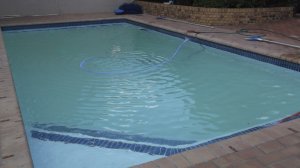Monitoring the use of pool pumps results in greater efficiency


PUMPING EFFICIENTLY Monitoring the use of pumps results in longer lasting and cost effective pump use
Pool maintenance and renovations company Pool Busters notes that monitoring pool pumps can lead to greater savings.
“Using a pool pump that is popular in the market and readily available doesn’t guarantee savings or effective use. If a pool pump is selected on its availability at a lower price, then homeowners who have pools should be prepared to discard it when it fails, rather than repairing it,” says Pool Busters MD Brian Scheckle.
He explains that effective use in terms of saving power depends on when and for how long the pool pump is used, which will affect the energy consumption and durability of the pumps.
“Most pool chemicals suppliers recommend that the pump be used 12 h/d in summer. At a typical 1 kW input, the pump equates to 12 kWh/d, which costs about R360/m. After maintaining about 400 swimming pools of varying sizes over the past 12 years, our experiences of how to optimise the use of pumps do differ.”
He points out that a pool pump has two primary functions – vacuuming the pool floor to keep it free of debris and filtering the water. “In our experience, these functions can be adequately achieved by running the pump for as little as 4 h/d.”
However, a pool in a residential complex with high traffic in users will require additional filtering and additional chemicals, which, in turn, will result in more regular use of the single-phase pump, he explains.
Scheckle notes that, in terms of traffic, the average domestic swimming pool is very different. “Many of our clients use their swimming pools only on weekends, with as few as two to four swimmers using the pool.”
He emphasises, however, that maintaining pools only once they are in a bad condition will result in excessive use of chemicals and energy to filter cloudy water, as well as water to vacuum the waste when necessary.
Moreover, Scheckle asserts that, in winter, many pools remain crystal clear when the pump has been switched off, owing to chemicals being added regularly, which results in silt accumulating on the pool floor, which can be vacuumed at the appropriate time. He reiterates that monitoring the pool eliminates the need to run the pool pumps during a period where little to no swimming takes place.
He explains that, as a result of sufficient chemical use during periods, such as winter, a pool pump set to vacuum can be used to clear the silt waste and return the pool to a clean condition when spring has returned. “This results in a 100% energy saving for four months a year and no need for 2 000 ℓ backwashes. The vacuum of waste, if done efficiently, will, moreover, use 1 000 ℓ of water and the pumps will last longer,” he stresses.
It is important to note that the secondary functions of a pool pump can change if the pool is equipped with a salt chlorinator or solar heating, as the pump is required to produce chlorine through the chlorinator or heat the water through the solar heating panels.
“The time of running the pool pump will then have to be decided based on the results obtained, compared with what is desired,” he highlights.
Scheckle concludes that the user will, through trial and error, be able to determine the minimum requirement for running the pool pump based on results. Larger pools will require longer periods of filtering because of the volume of water and size of the pool floor, but if monitored and used when necessary, the pool will remain cleaner for longer without the pumps being overused, also resulting in energy savings.
Article Enquiry
Email Article
Save Article
Feedback
To advertise email advertising@creamermedia.co.za or click here
Comments
Press Office
Announcements
What's On
Subscribe to improve your user experience...
Option 1 (equivalent of R125 a month):
Receive a weekly copy of Creamer Media's Engineering News & Mining Weekly magazine
(print copy for those in South Africa and e-magazine for those outside of South Africa)
Receive daily email newsletters
Access to full search results
Access archive of magazine back copies
Access to Projects in Progress
Access to ONE Research Report of your choice in PDF format
Option 2 (equivalent of R375 a month):
All benefits from Option 1
PLUS
Access to Creamer Media's Research Channel Africa for ALL Research Reports, in PDF format, on various industrial and mining sectors
including Electricity; Water; Energy Transition; Hydrogen; Roads, Rail and Ports; Coal; Gold; Platinum; Battery Metals; etc.
Already a subscriber?
Forgotten your password?
Receive weekly copy of Creamer Media's Engineering News & Mining Weekly magazine (print copy for those in South Africa and e-magazine for those outside of South Africa)
➕
Recieve daily email newsletters
➕
Access to full search results
➕
Access archive of magazine back copies
➕
Access to Projects in Progress
➕
Access to ONE Research Report of your choice in PDF format
RESEARCH CHANNEL AFRICA
R4500 (equivalent of R375 a month)
SUBSCRIBEAll benefits from Option 1
➕
Access to Creamer Media's Research Channel Africa for ALL Research Reports on various industrial and mining sectors, in PDF format, including on:
Electricity
➕
Water
➕
Energy Transition
➕
Hydrogen
➕
Roads, Rail and Ports
➕
Coal
➕
Gold
➕
Platinum
➕
Battery Metals
➕
etc.
Receive all benefits from Option 1 or Option 2 delivered to numerous people at your company
➕
Multiple User names and Passwords for simultaneous log-ins
➕
Intranet integration access to all in your organisation

















